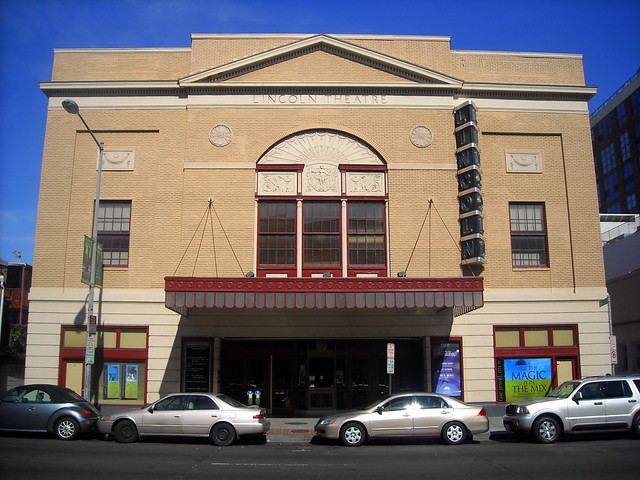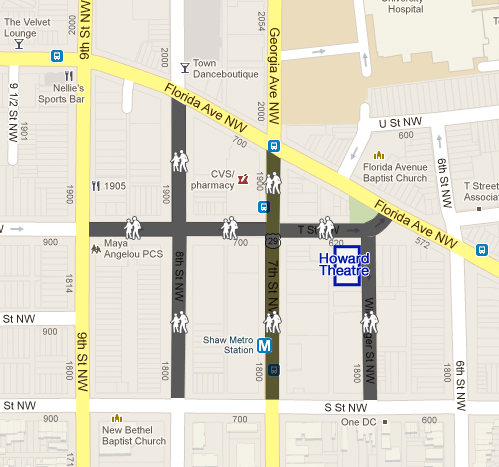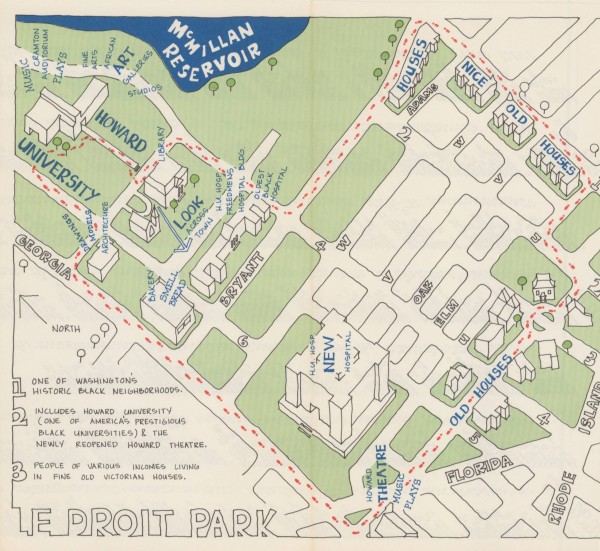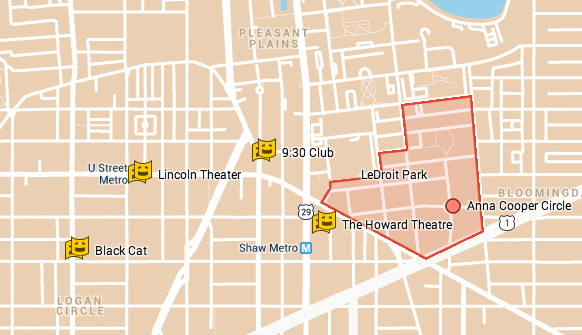A bicentennial map depicts LeDroit Park in 1975
DDOT posted this map of DC published in 1975 to celebrate the bicentennial. The map includes a section on LeDroit Park. Notice the groovy font, the “new” Howard University Hospital, the “nice old houses”, the long-gone bakery, and the “newly reopened Howard Theatre.” The Howard Theatre had briefly reopened from 1975 to 1980.
Reminder: Free history walking tour of LeDroit Park this weekend


Come on out Saturday or Sunday for a free history walking tour of LeDroit Park. I conduct this tour annually as part of WalkingTown DC.
The tours will be on Saturday, October 5 at 1 pm and again on Sunday, October 6 at 10 am. Meet me at the arch at 6th Street and Florida Avenue NW. The tours are free and open to the public. No reservations are required.
We’ll cover
- The neighborhood’s founding
- Relationship with the Howard Theatre
- Architectural history
- The Park at LeDroit
- Walter Washington
- Ernest Everett Just
- Robert & Mary Church Terrell
- Anna Julia Cooper
- William Birney
- Edward Brooke
- Octavius Williams
- Oscar De Priest
- Griffith Stadium
The Lincoln Theater is back in business

Photo by NCinDC on Flickr
The Post reports that music venue owner IMP, which operates the 9:30 Club and Merriweather Post Pavilion, is now managing the District-owned Lincoln Theater.
As we noted before, the Lincoln Theater’s revival in the 1990s failed to measure up to the Howard Theatre’s recent rebirth. Last year we compared the number of scheduled events at both theaters from May 11 to June 30, 2012. The contrast was stunning as the Howard had announced 51 scheduled events compared to the Lincoln’s paltry five.
The District’s new operator for the Lincoln has already booked comedians Ira Glass and Cheech and Chong, as well as musical performers Janelle Monae, Soundgarden’s Chris Cornell, and KT Tunstall for next month.
The Lincoln is just one of four big venues within a mile of LeDroit Park:
| Theater | Distance | Capacity |
|---|---|---|
| Howard Theatre | 0.3 mi | 600 if seated; 1,000 if standing |
| 9:30 Club | 0.6 mi | 1,200 standing |
| Lincoln Theater | 0.8 mi | 1,225 seated |
| Black Cat | 1.0 mi | 700 standing and 200 in the backstage |
The Lincoln Theater’s 1,225 fixed seats set the venue apart. Though this configuration limits the types of acts that will perform, it also guarantees each patron a reserved space.
Check out the Post’s handy comparison chart, including typical headliners and food options for each venue.
Street closures for Chuck Brown’s viewing

Chuck Brown, the Godfather of Go-go, died on May 16. That night a crowd of fans celebrated his life and mourned his death in front of the Howard Theatre.
Brown’s viewing will be held at the Howard Theatre on Tuesday, May 29, from 11 am to 10 pm. To accomodate the expected crown of mourners, DDOT will close several streets to private automobiles on Tuesday. T Street from 7th Street to Florida Avenue will close from 3 am to midnight. The following streets will close from 9:30 am to midnight:
- T Street between 9th Street and Florida Avenue
- 7th Street between Florida Avenue and S Street
- 8th Street between Florida Avenue and S Street
- Wiltberger Street between T Street and S Street
You may still walk or bike along these streets, but if you’re driving, it will be best to avoid the area.
The Howard Theatre and the value of public investment
The Howard Theatre’s renovation, in which the District government invested $12 million, got us thinking about the role of public finance in development projects. The use of public money or, alternatively, the granting of tax abatements to private projects, elicits controversy. Opponents argue that such investments are give-aways to well-connected businessmen.
 In the case of the Howard Theatre, the District’s investment in the venue, which the District government technically owns, is a good investment that is economically justified. The new venue and streetscape in front will improve the perception of the area and thus improve property values in LeDroit Park. The former is an improvement to the quality of life while the latter is an improvement to the District’s tax base.
In the case of the Howard Theatre, the District’s investment in the venue, which the District government technically owns, is a good investment that is economically justified. The new venue and streetscape in front will improve the perception of the area and thus improve property values in LeDroit Park. The former is an improvement to the quality of life while the latter is an improvement to the District’s tax base.
Though the theater is technically just outside LeDroit Park, the path from the Shaw Metro Station to LeDroit Park typically brings people in front of the theater. When the District-owned theater was decaying and vacant, it served as an awful first impression of the area. A barbed wire fence under the awning and marquee made visitors well aware that a strong wind gust could cause the awning to collapse. The heaps of litter and scurrying of rats certainly didn’t help perceptions, either.
Work crews are reconstructing the entire street, including sidewalks and lamp posts, and when the renovated theater opens next month, much of the former blight will be removed. Smooth, wheelchair-accessible sidewalks will replace broken concrete. Lamp posts will provide ample light. A statue on the sidewalk and a statue atop the theatre will add to the sense of place for this important historic venue.
The theater itself, renovated and gleaming, will attract patrons several nights a week and the building will have to remain in good order. Clean surfaces and façade adornments will replace trash, decay, and danger. The block will be unrecognizable from before.
These improvements will undoubtedly improve how visitors and residents view the block and perhaps how they view LeDroit Park. The quality of life improvements are certain. From a financial standpoint, the improvements will likely boost surrounding property values and thus property tax revenues for the District. In doing so, the additional revenue may far exceed the $12 million of public money invested in the site.
Correction: An earlier version of this post understated the dollar amount of the city’s investment.
7th & T was always the seedier end of the U Street corridor
This is the second in a series on the Scurlock photo archive. Read the first entry.
During the Jazz Age of the 1920s and later into the 1930s, U Street was dubbed the “black Broadway” as it featured such venues as the Lincoln Colonnade (now the Lincoln Theater), the Howard Theatre, and other clubs and restaurants. In a segregated city in which blacks were excluded from most restaurants, theaters, and stores, U Street served as a refuge to catch a show and enjoy a meal.
This photo from the Scurlock archives was taken looking east at 7th and T Streets NW in 1939.
[Toggling between now and then photos will not work in RSS readers. View the actual post]
We have referred to this area as the block of blight for its dilapidated buildings, copious litter, and frequent police arrests. It turns out that some things never change. Even when this photograph was taken, U Street was not uniform in character and the area around the Howard Theatre was considered downscale compared to the classier venues west on U Street. (For more on U Street’s evolution, see Blair Ruble’s recent book, Washington’s U Street: A Biography.)
Pictured here at the corner is National Grill, which, like Harrison’s Café in LeDroit Park, advertised itself as open all night. The lighted vertical sign attached to the façade appears to read “LUNCH” and the pediment at the cornice bears the building’s name, “Scott’s”. (View a larger version of the photo.)
Just to the right (south) of National Grill is the S.W. Keys Luncheonette, whose vertical sign advertises coffee and waffles. Just south of that is Harlem Cafe, located in a building that has since been replaced.
On T Street, just behind Scott’s Building and just before the Howard Theatre, you will see a sign that reads “BILLIARDS”. That marks Frank Holliday’s pool hall, a popular gathering spot for Howard scholars, jazz musicians, and city laborers alike. Duke Ellington captured the scene at the pool hall:
Guys from all walks of life seemed to converge there: school kids over and under sixteen; college students and graduates, some starting out in law and medicine and science; and lots of Pullman porters and dining-car waiters.
Just beyond the pool hall, you’ll see the Howard Theatre sporting its original Italianate façade. The theater was later covered with plaster, which was only recently removed for the restoration project.
Today the last two buildings on 7th Street are a Chinese take-out and a tiny market. One of the developers of Progression Place, the large development project underway on the block (rendering below), said that the late owner of these two buildings refused to sell to his development. Progression Place will incorporate every building on this block except for these two.
If anyone is looking for a two-building restoration project, here is your chance!










Recent Comments